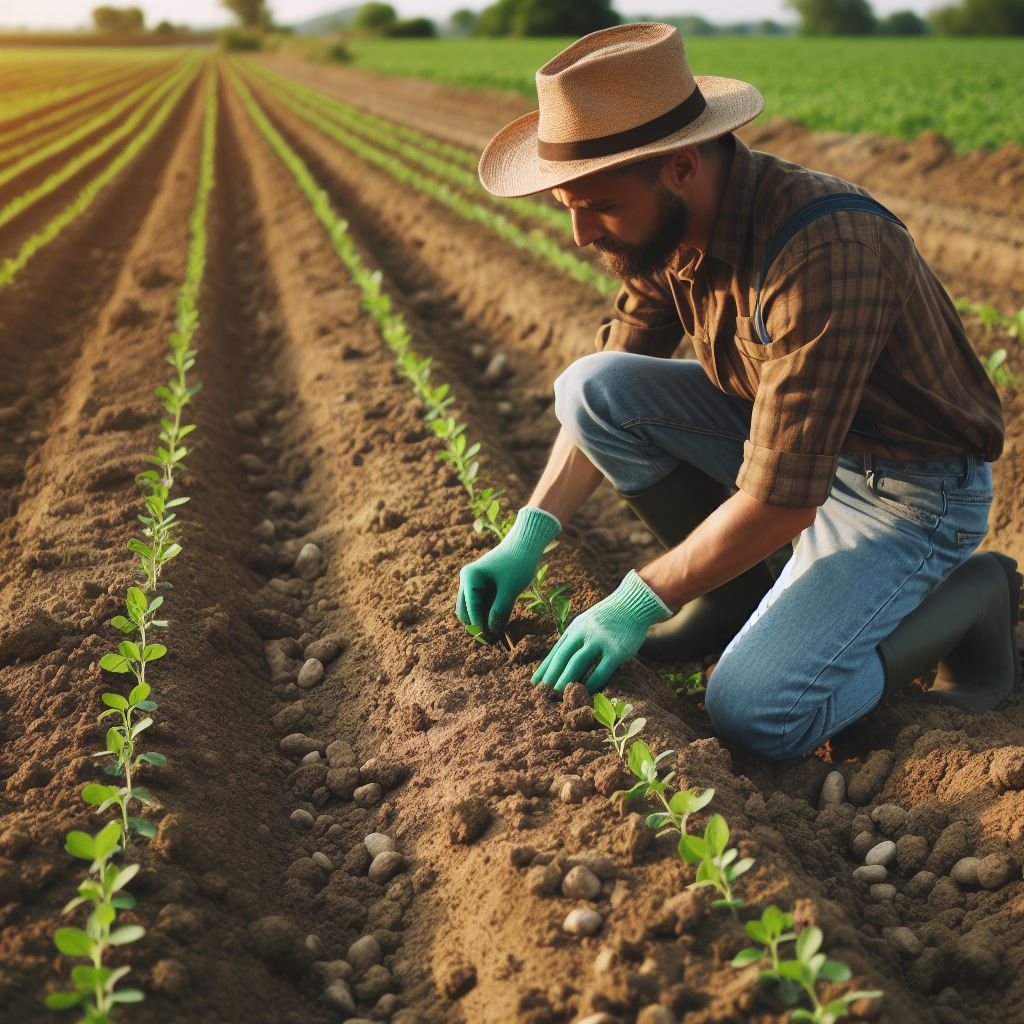Introduction
Drought-tolerant crops are crucial for ensuring food security in areas with limited water resources.
Also, Drought-tolerant crops play a crucial role in ensuring global food security by withstanding water scarcity challenges.
As climate change intensifies, unpredictable and prolonged droughts threaten traditional crops, jeopardizing agricultural productivity.
Drought-tolerant varieties, equipped with resilient genetics, can endure water stress, ensuring crop yields even in arid conditions.
These crops mitigate the impact of climate-induced water shortages on food production, safeguarding farmers’ livelihoods and stabilizing food prices.
Emphasizing and adopting drought-tolerant crops contribute to building sustainable and resilient agricultural systems, enhancing the world’s ability to meet the nutritional needs of a growing population amidst environmental uncertainties.
Growing drought-tolerant crops conserves water, reduces the need for irrigation, and minimizes crop failures.
It offers numerous advantages in the face of climate change and water scarcity. These crops exhibit resilience to water stress, ensuring more stable yields in arid regions.
Farmers benefit from reduced irrigation needs, lowering water expenses and conserving scarce resources.
Enhanced crop productivity in drought-prone areas contributes to food security, mitigating the impact of changing weather patterns on agriculture.
Additionally, the cultivation of drought-resistant varieties promotes sustainable farming practices, reducing environmental strain.
Overall, investing in and adopting drought-tolerant crops bolster agricultural resilience, support food production, and address the challenges posed by climate-induced water shortages.
Definition and Characteristics of Drought-Tolerant Crops
A. Definition of drought-tolerant crops
Drought-tolerant crops are plants that possess unique adaptations allowing them to withstand prolonged periods of limited water availability.
These crops have the ability to survive and continue their growth even in arid conditions.
B. Characteristics that make a crop drought-tolerant
- Deep Root Systems: Drought-tolerant crops possess extensive root systems that enable them to access water from deeper soil layers, reducing their dependence on surface water sources.
- Efficient Water Use: These crops have evolved mechanisms to efficiently use available water resources. They often have small leaves or specialized structures that minimize water loss through transpiration.
- Drought Avoidance: Some drought-tolerant crops have developed strategies to avoid drought altogether. They may enter a dormant stage during times of water scarcity, reducing their water requirements until conditions improve.
- Drought Resistance: Drought-tolerant crops have built-in resistance mechanisms such as the ability to store water in their tissues or adjust their metabolism to cope with water stress.
C. Examples of commonly grown drought-tolerant crops
- Maize: Maize, also known as corn, is a highly adaptable and drought-tolerant crop. It has deep root systems and is capable of efficiently using water, making it a staple in many arid regions.
- Sorghum: Sorghum is a nutritious cereal crop that thrives in dry conditions. It has a remarkable ability to tolerate drought due to its deep roots and efficient water-use strategies.
- Millet: Millet is a versatile grain crop that can grow in a wide range of environments, including drought-prone areas. It has strong resistance mechanisms, making it a reliable choice in dry regions.
- Cowpea: Cowpea, also known as black-eyed pea, is a resilient legume crop that performs well in water-limited conditions. It has developed mechanisms to efficiently use water, making it a valuable food source in arid regions.
- Agave: Agave is a succulent plant that can thrive in extremely dry environments. Its ability to store water in its tissues and its high adaptability make it an ideal drought-tolerant crop.
- Quinoa: Quinoa is a nutritious pseudocereal with exceptional resilience to drought conditions. Its deep root systems and efficient water use contribute to its ability to thrive in arid regions.
- Olive: Olive trees have adapted to arid Mediterranean climates, making them a prime example of a drought-tolerant crop. Their deep roots and ability to resist water stress contribute to their long lifespan.
All in all, drought-tolerant crops possess unique characteristics that enable them to survive and thrive in water-limited conditions.
Transform Your Agribusiness
Unlock your farm's potential with expert advice tailored to your needs. Get actionable steps that drive real results.
Get StartedTheir deep root systems, efficient water use, and built-in resistance mechanisms make them invaluable assets in mitigating the impact of drought on agricultural productivity.
From staple crops like maize and sorghum to lesser-known plants like agave and quinoa, these crops offer sustainable solutions for regions facing water scarcity challenges.
By incorporating more drought-tolerant crops into our farming systems, we can enhance food security and build resilience in the face of changing climatic conditions.
Selecting the Right Drought-Tolerant Crops for Your Farm
A. Assessing water availability on the farm
When selecting drought-tolerant crops for your farm, it is crucial to assess the availability of water.
Consider the amount of water you have access to and the reliability of its supply.
Evaluate the sources, such as wells, rivers, or rainwater collection systems, and determine their capacity.
Calculate the water requirements of different crops and match them with your available resources.
Be realistic about your water limitations and choose crops that can thrive with the available water supply.
B. Considering the climate and weather patterns
Another important factor to consider when selecting drought-tolerant crops is the climate and weather patterns in your region.
Research the average temperature, precipitation levels, and the occurrence of droughts.
Identify crops that are well-suited to your specific climate conditions and are capable of withstanding dry spells.
Choose crops that have proven resilience to local weather patterns to ensure a successful harvest.
C. Evaluating soil conditions
The soil conditions on your farm play a significant role in determining the suitability of drought-tolerant crops.
Assess the soil type, structure, and fertility to understand its water-holding capacity and drainage capabilities.
Crops that can tolerate a range of soil types, including sandy or clayey soils, may be better suited to drought conditions.
Consider conducting soil tests to identify nutrient deficiencies and pH levels, and amend the soil accordingly.
Choose crops that are adaptable to your soil conditions, ensuring optimal growth and drought resilience.
D. Researching crop options suitable for the region
Lastly, conduct thorough research on crop options that are known to be suitable for your specific region.
Consult local agricultural extension offices, universities, and experienced farmers for advice and recommendations.
Consider the historical success of crops in your area and take into account any government guidelines or incentives.
Explore drought-tolerant varieties and hybrids that have been developed specifically for your region’s conditions.
By selecting crops that are well-adapted to your region, you increase the chances of achieving a successful harvest even during periods of drought.
In fact, selecting the right drought-tolerant crops for your farm requires careful consideration of water availability, climate and weather patterns, soil conditions, and regional suitability.
By taking these factors into account, you can choose crops that have the best chance of thriving in water-limited environments.
Showcase Your Farming Business
Publish your professional farming services profile on our blog for a one-time fee of $200 and reach a dedicated audience of farmers and agribusiness owners.
Publish Your ProfileResearch, consult with experts, and utilize local resources to make informed decisions that optimize your farm’s productivity and resilience.
Read: Crop Rotation Secrets for Healthy Soil
Popular Drought-Tolerant Crop Options
A. Maize
Maize, also known as corn, is a popular crop choice for farmers in many regions.
However, drought conditions pose a significant challenge to its cultivation.
To overcome this challenge, several drought-tolerant maize varieties have been developed.
Drought-tolerant maize varieties possess specific characteristics that enable them to withstand water scarcity.
These varieties have deep root systems that access water deeper in the soil, minimizing their dependence on surface moisture.
Additionally, they have the ability to close their stomata, reducing water loss through transpiration.
These traits make them more resilient during dry periods.
To successfully cultivate maize in drought conditions, farmers should follow specific tips and techniques.
First, it is essential to select the appropriate maize variety that is specifically bred for drought tolerance.
These varieties have been developed through extensive research and breeding programs.
Another crucial technique is to implement efficient irrigation methods.
Drip irrigation, for example, can minimize water wastage and ensure that water is directly delivered to the roots.
Mulching the soil around maize plants can also help retain moisture and reduce evaporation.
Furthermore, proper soil management is crucial in drought conditions.
Implementing conservation practices, such as cover cropping and conservation tillage, can improve soil moisture retention and prevent erosion.
These practices also enhance soil organic matter content, which helps with water infiltration and retention.
B. Sorghum
Moving on to sorghum, it is a versatile crop that is well-known for its ability to withstand drought.
Sorghum plants have evolved various mechanisms to survive harsh conditions.
These include deep root systems, which enable them to access water deep below the surface, and the ability to store water within their stalks.
To successfully grow sorghum in dry areas, farmers should follow best practices for its cultivation.
Planting sorghum early in the season allows it to establish deep roots before encountering severe water stress.
Conservation tillage practices can also help retain moisture in the soil, ensuring the availability of water for sorghum plants.
Proper timing of irrigation is crucial for sorghum. Irrigating during critical growth stages, such as flowering and grain filling, ensures optimal yield.
However, excessive irrigation should be avoided, as it can lead to nutrient leaching and root diseases.
C. Beans
Beans are another popular choice for drought-tolerant crops.
There are various drought-tolerant bean varieties available that can withstand arid conditions.
These varieties have been bred to possess traits such as deep root systems and efficient water usage.
To maximize bean yields in arid conditions, specific cultivation techniques should be employed.
Proper soil preparation, including adequate drainage and soil fertility management, ensures optimal root development and nutrient uptake.
Mulching the soil can help conserve moisture and suppress weed growth.
Timely and precise irrigation is crucial for bean cultivation in arid conditions.
Watering early in the morning or late in the evening minimizes water loss due to evaporation.
Additionally, drip irrigation or furrow irrigation systems can be utilized to deliver water directly to the root zone, minimizing wastage.
In essence, selecting drought-tolerant crop options is essential for farmers facing water scarcity.
Maize, sorghum, and beans are popular choices due to their ability to withstand dry conditions.
By choosing the appropriate varieties and implementing specific cultivation techniques, farmers can ensure successful crop production even in drought-prone areas.
Read: Microbe Magic: Enhancing Soil Health

Cultivating Drought-Tolerant Crops
A. Preparing the soil for planting
- Begin by removing any debris or weeds from the planting area.
- Test the soil to determine its pH level and nutrient content.
- Add organic matter, such as compost or manure, to improve soil structure and fertility.
- Use raised beds or furrows to improve drainage and conserve moisture.
- Ensure proper soil depth and loosen compacted soil to promote root growth.
B. Water management strategies for drought-tolerant crops
- Implement mulching techniques to conserve soil moisture and regulate temperature.
- Use efficient irrigation methods like drip irrigation or soaker hoses to minimize water loss.
- Group plants with similar water needs together to optimize watering practices.
- Monitor soil moisture levels regularly and water the crops only when necessary.
- Consider rainwater harvesting systems to supplement water supply during dry periods.
C. Proper fertilization and nutrient management
- Conduct a soil test to determine nutrient deficiencies and apply fertilizers accordingly.
- Use slow-release fertilizers to provide a steady supply of nutrients over time.
- Apply organic fertilizers to enhance soil fertility and improve nutrient absorption.
- Avoid excessive fertilization, as it may lead to weaker plants and increased water requirements.
- Apply micronutrients if necessary, as some drought-tolerant crops may have specific requirements.
D. Pest and disease control measures specific to drought-tolerant crops
- Implement integrated pest management (IPM) practices to control pests without excessive pesticide use.
- Inspect plants regularly for any signs of pests or diseases and take necessary action promptly.
- Encourage beneficial insects and natural predators to control pest populations.
- Practice crop rotation to reduce the build-up of pest and disease populations in the soil.
- Use resistant varieties or hybrids of drought-tolerant crops that are less susceptible to pests and diseases.
Proper cultivation techniques are essential for successfully growing drought-tolerant crops.
Showcase Your Farming Business
Publish your professional farming services profile on our blog for a one-time fee of $200 and reach a dedicated audience of farmers and agribusiness owners.
Publish Your ProfileBy preparing the soil properly, managing water effectively, ensuring proper fertilization, and implementing pest and disease control measures, farmers and gardeners can maximize their yields and resilience to water shortages.
Let’s cultivate drought-tolerant crops with success!
Read: Managing Soil Salinity for Better Yield
Important Considerations for Successful Drought-Tolerant Crop Cultivation
A. Efficient irrigation techniques
- Implement drip irrigation systems to deliver water directly to plant roots.
- Use mulch to reduce evaporation and retain soil moisture during dry periods.
- Regularly monitor soil moisture levels to avoid over or under-irrigation.
- Consider using rainwater harvesting techniques to supplement irrigation needs.
- Implement precision irrigation techniques like soil sensors or weather-based irrigation scheduling.
B. Crop rotation and diversification for sustained productivity
- Rotate crops to reduce disease and pest pressure and improve soil health.
- Choose drought-tolerant crop varieties and alternate them with water-demanding crops.
- Include cover crops in the rotation to improve soil fertility and organic matter content.
- Diversify crops to reduce the dependency on a single crop and mitigate risks associated with drought.
C. Monitoring and managing crop stress during drought periods
- Regularly monitor crop health and growth to identify early signs of stress.
- Implement proper weed control measures to reduce competition for limited water resources.
- Apply appropriate agronomic practices like nutrient management to help crops cope with drought stress.
- Use crop-specific techniques like pruning or defoliation to optimize water usage and enhance plant resilience.
D. Harvesting, storage, and post-harvest management practices
- Time the harvest to minimize exposure of crops to severe drought conditions.
- Ensure efficient post-harvest handling and storage to minimize moisture loss and spoilage.
- Utilize appropriate drying techniques for preserving crop quality and preventing mold formation.
- Implement proper packaging and transportation practices to prevent post-harvest losses.
Successful cultivation of drought-tolerant crops requires careful consideration and implementation of various practices.
Efficient irrigation techniques such as drip irrigation and mulching can significantly reduce water consumption.
By implementing crop rotation and diversification strategies, farmers can maintain productivity while reducing the impact of drought.
Monitoring crop stress and implementing appropriate measures can help crops survive and even thrive during drought periods.
Finally, proper harvesting, storage, and post-harvest management practices are essential for maximizing crop yield and quality.
By combining these strategies, farmers can cultivate drought-tolerant crops successfully and contribute to sustainable agriculture.
Read: Water Management in Soil Fertility
Conclusion
In this blog post, we discussed the key points regarding drought-tolerant crops emphasizing the importance of resilient agriculture in the face of climate change.
It outlines key criteria for selecting such crops, including deep root systems, efficient water use, and stress tolerance.
The post highlights specific drought-tolerant varieties like sorghum, millet, and certain legumes, detailing their characteristics and adaptability.
Crop management practices, such as conservation tillage and mulching, are also explored to enhance water retention.
Additionally, the blog stresses the role of technology, citing precision irrigation and genetic engineering as tools to improve drought resistance.
Overall, the guide provides valuable insights for sustainable and resilient farming practices.
We encourage farmers to explore these crops for sustainable agriculture in the face of drought.
Looking to the future, advancements in drought-tolerant crop research hold promise for even more resilient options.




